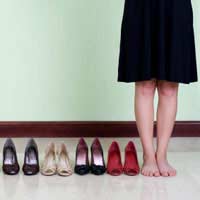How to Choose Footwear as You Age: A Case Study

Linda’s feet had been bothering her for some time but she was too busy to give them much notice. With her daughter starting a new job and setting up in her own apartment, her husband’s plans for a wedding anniversary cruise and her own - to get in shape for her 50th birthday, she had too much on her mind to think about her feet.
So she ignored the pain and soreness as best she could and tried over-the-counter creams on the various bunions and calluses which seemed to be forming on her feet with increasing frequency. But while out shopping with her daughter one day, Linda winced as she tried to hurry down some steps and nearly tripped – her daughter insisted on taking her to see a podiatrist.
Visiting the Podiatrist
“It was only when the podiatrist started asking me all these questions that I realised how much I’d been neglecting my feet!” recalls Linda. “I mean, I knew I was getting older and I’d been revamping my wardrobe to suit my figure now and also been to the salon to get a new hairstyle…but I’d never really thought about my shoes!”Linda discovered that although she always quoted her shoe size as that from her twenties, it had in fact gone up by a full size. No wonder her shoes had been feeling tight and uncomfortable lately!
Feet Sizes Change as We Age
“The podiatrist also explained to me that we age, our feet changes – like the tendons and ligaments get looser, so our feet get longer and sort of flatter, which means we lose our arches and our ankles tend to roll inwards. This is probably what happened to me on those stairs and I nearly sprained an ankle! Also, the fat pads which cushion the bottom of our feet start to thin out, so our feet get a lot more sore and painful from just walking or even standing around, because they can’t bear the weight so well anymore.”Linda also found out that there was a reason for all the bunions and calluses which kept developing, especially on her big toe. Again, as the feet become wider and longer and less padded, the arch lowers and this pulls the big toe up. If the shoe is then too tight as well, the big toe will keep rubbing against the top of the shoe, causing painful bunions and even possibly damaging the toe nail.
With advice from the podiatrist, Linda set out on a shoe shopping spree to look for replacements which would not only be the right size and fit better but also provide better support and cushioning for her ageing feet.
Different Shoes and Losing Weight
“I started looking at shoes in a totally different way,” laughs Linda. “It wasn’t just about sexy heels anymore! Now I was looking to see if there was cushioning in the heel and insoles and whether the front part was wide enough.”“Of course, size is really important – I didn’t just go by a number now but tried on everything and walked around to make sure they were comfortable once I put my weight in them. I found that I could be a completely different shoe size in different brands. The key was making sure that there was at least 1cm of space in front of my longest toe – which was my big toe, in my case," says Linda. "I also looked for shoes that were more flexible and which would mould to the shape of my feet, rather than the other way around!”
In addition to her new shoes, Linda followed the advice of her podiatrist in first losing some weight, so that her feet would have to cope with less pressure bearing down on them all the time, and secondly, starting to do regular exercise to strengthen her calf muscles.
“I never knew this but if your calf muscles are out of shape, it pulls on the tendons and ligaments in your feet even more. So toning up my calf muscles really made a difference – I noticed that my feet weren’t so sore at the end of the day – and there was the added bonus that my legs looked a lot better!” chuckles Linda. “It didn’t involve much – just some basic stretching and weight-bearing exercises to improve the circulation and strengthen the muscles. This also helps to prevent bone loss too, so reducing the risk of osteoporosis and fractures. A winner all around!”








